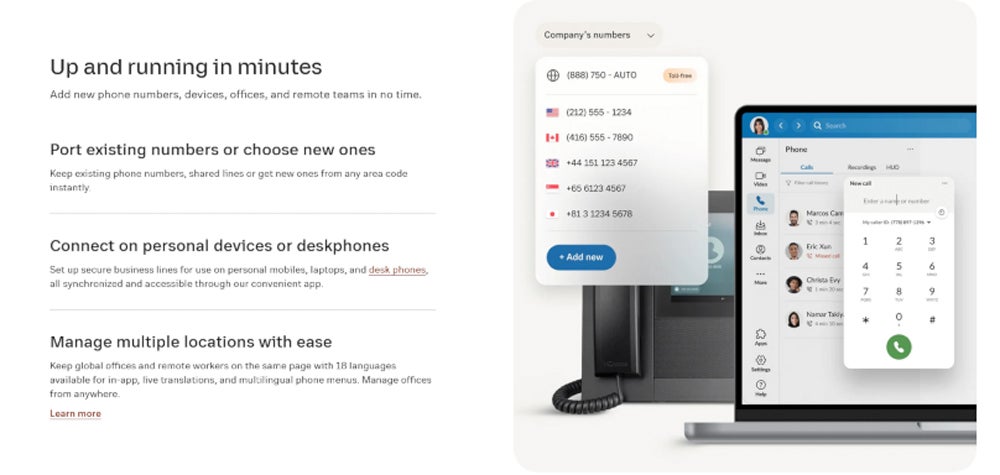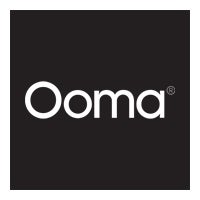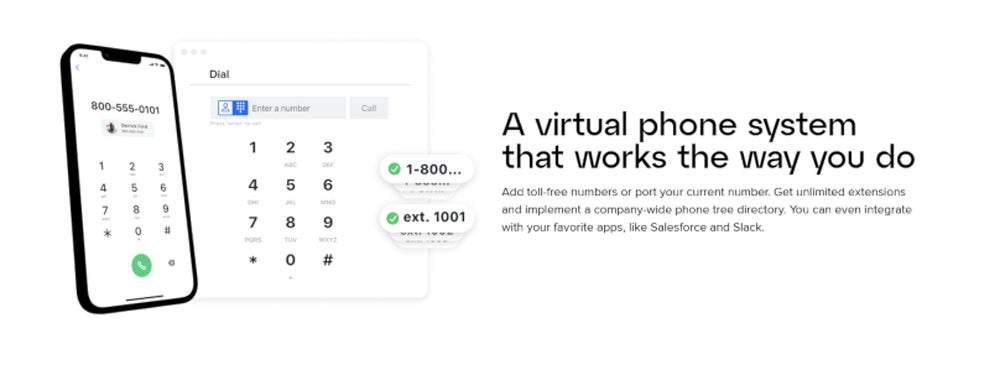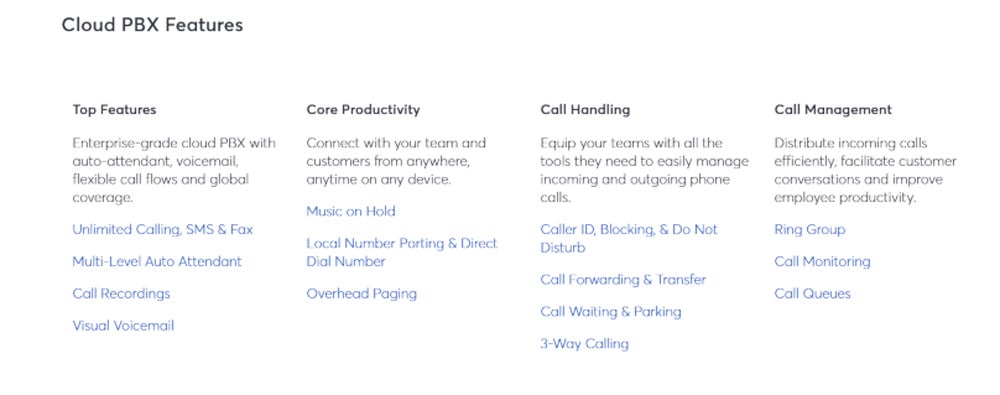I’ve looked into just about every business phone system on the market. Along the way, I uncovered the best SIP trunk providers based on pricing, setup, customer service, features and integrations.
1
CloudTalk
CloudTalk
Employees per Company Size
Micro (0-49), Small (50-249), Medium (250-999), Large (1,000-4,999), Enterprise (5,000+)
Any Company Size
Any Company Size
Features
24/7 Customer Support, Call Management/Monitoring, Contact Center, and more
Top SIP trunking providers comparison
At their core, most SIP trunking providers deliver a similar service. However, there are a few nuances to consider, particularly around pricing, your location, integrations and overall value.
| Nextiva | ||||||
| RingCentral | ||||||
| Ooma | ||||||
| GoTo Connect | ||||||
| Intermedia Unite | ||||||
| 8×8 |
Nextiva: Best SIP trunk provider overall
Nextiva eliminates the usual hassles associated with setup and onboarding with a quick and easy SIP trunking implementation process. With metered and unmetered plans, it’s a great choice whether you rarely make calls or have a team of agents on the phones all day.
Why I chose Nextiva
Nextiva is an affordable, fluff-free solution. Small businesses and enterprises alike can transition communications to the cloud with SIP trunking, an all-in-one business phone system, powerful contact center solutions or a combination of all three. No matter what you need, Nextiva’s superior customer service is tough to beat.
Pricing
- Metered: $14.95 per month + $0.008 per minute after the first 100.
- Unmetered: $24.95 per month with no per minute fees.
Features
- Online account, user and line management.
- Built-in fraud protection.
- Enhanced 911 capabilities.
- Automated failover routing.
- Log of detailed call records.
- Free local or toll-free number.
- 100 free minutes on the metered plan.
- Volume discounts at scale.
- Same day setup in most cases.

Pros and cons
| Pros | Cons |
|---|---|
|
|
RingCentral: Best for enterprises

While largely known for world-class, cloud-based phone systems, RingCentral also offers flexible SIP trunking with low-latency voice connectivity and phased cloud migration support. With a massive library of more than 300 pre-built integrations, you’ll be able to sync your modernized system as you transition with your other business tools.
Why I chose RingCentral
Mid-size and large enterprises that need an array of communication capabilities or a guided approach to cloud migration will appreciate RingCentral. Their powerful phone systems, contact center solutions and SIP trunking options in 50+ countries give you all the flexibility you need to modernize communications in a way that makes sense for your business. You can even choose to host your data in the U.S., Canada, the U.K. or Germany.
Pricing
Cloud Connector is RingCentral’s SIP trunking and cloud transition solution. Pricing is based on a custom quote. Since it’s meant for enterprises and large teams, you can expect it to be one of the more expensive options on my list.
Features
- Expert guidance as you migrate to the cloud.
- Supported in more than 50 countries.
- Massive library of pre-built integrations.
- Free phone numbers if you need them.
- Automatic failover routing any time.
- Fully redundant architecture.
- Centralized management of all VoIP, contact center and SIP users.

Pros and cons
| Pros | Cons |
|---|---|
|
|
Ooma: Best for SIP and IP trunking

Ooma is well known for its easy DIY phone systems for residential and in-person offices. However, it also offers enterprise support for SIP and IP trunking, along with a wide range of other complicated communication needs. While some SIP trunking providers don’t offer any extra features, Ooma includes analytics, customizable call flows and centralized device management.
Why I chose Ooma
Unlike a lot of the other providers on my list, Ooma supports analog PBX systems along with IP-enabled devices. You can also leverage IP trunking for other types of communication beyond voice. Handling video conferencing, messaging and other types of data is no problem. This also unlocks integrations and general internet connectivity for IP-enabled devices.
Pricing
SIP and IP trunking are available via Ooma’s enterprise communications services. Pricing for these is custom, based on what you need. Despite the word “enterprise” in the name, Ooma’s known for its affordability and focus on ease of use for businesses of all sizes; you can expect pricing to reflect that.
Features
- Supports voice, video, texting and messaging.
- Built-in call analytics and call flows.
- Supports analog PBX systems.
- Unlimited usage options.
- Streamlined device and user management.

Pros and cons
| Pros | Cons |
|---|---|
|
|
GoTo Connect: Best integrations

GoTo Connect offers SIP trunking services alongside its feature-rich VoIP and call center platform. However, it stands out for its deep integrations with well known CRM systems, collaboration tools, support platforms and marketing automation suites. Aside from standard SIP trunking capabilities, you’ll be able to connect your legacy phone system to the tools your team uses every day.
Why I chose GoTo Connect
From automatic call logging, click-to-dial and interaction tracking to in-app notifications, ticket creation, call scheduling, lead management and audience segmentation, your team can enjoy a more connected communication experience. You can also adjust bandwidth for each trunk based on demand, so you don’t have to overpay for unused capacity.
Pricing
All of GoTo Connects plans are based on a custom quote tailored to your business. It depends on the capabilities you need, the number of users and the length of your contract.
Features
- Strong integrations with popular tools.
- Automated failover routing options.
- Fine-tuned bandwidth adjustments.
- Centralized device and user management.
- Affordable rates for all types of calls.

Pros and cons
| Pros | Cons |
|---|---|
|
|
Features
- Fully redundant, fail-proof architecture.
- 300 free long-distance minutes on the Bundled plan.
- Tons of optional features, like voicemail, faxing, auto attendant.
- Five-star 24/7 customer service.
- Intuitive monitoring portal.
- Automated notifications system.

Pros and cons
| Pros | Cons |
|---|---|
|
|
8×8: Best global coverage

8×8 stands out in the SIP trunking market for its global infrastructure. The company’s SIP trunking services are highly praised for their reliability and sophistication, as well as the excellent support that accompanies them. It boasts 16 data centers across five continents, offers full PSTN replacement in over 40 countries, support services in 157 countries and high call quality via local routing.
Why I chose 8×8
Aside from an extensive network, 8×8 supports a range of features, including local and toll-free numbers across numerous countries, redundancy for reliable service and competitive pricing. The emphasis on call quality and reliability—along with an architecture that ensures no single point-of-failure as well as guaranteed low packet loss and latency—makes it a great choice for performance reasons, too.
Pricing
8×8’s SIP trunking services are based on a custom quote that depends on your country, business size and a wide range of other factors.
Features
- Full PSTN replacement in 40 countries.
- Supported in 157 regions.
- Superior quality via local routing.
- 16 data centers across five continents.
- Guaranteed lo packet loss and latency.

Pros and cons
| Pros | Cons |
|---|---|
|
|
How do I choose the best SIP trunking provider for my business?
Selecting a SIP trunk provider involves evaluating your business communication needs, budget and the specific features offered by the provider. Look for providers with reliable uptime, quality customer support, scalable options and compatibility with your existing PBX system.
You should also choose a SIP trunking provider that offers comprehensive VoIP solutions, ensuring you’re prepared for your future cloud migration. Rather than adding new users to your SIP trunk, you can place them fully in the cloud from day one.
Doing this with the same provider allows for centralized user management.
Methodology
I incorporated my own experience, customer feedback, case studies and detailed spec sheets to put this guide together. I started with a list of dozens of SIP trunking providers, then narrowed it down to the best using the following criteria:
- Customer satisfaction: I looked for consistent positive feedback across various review platforms to ensure reliability and user satisfaction.
- Feature sets: The breadth and depth of features offered by each provider were examined, emphasizing those that primarily contribute to business communications.
- Pricing transparency: I favored providers who offered clear, straightforward pricing information, making it easier for businesses to understand their potential investments.
- Ease of integration: A key consideration was how well each SIP trunking service integrates with existing business systems, aiming for minimal disruption during implementation.
- Scalability: I assessed each provider’s ability to scale with a business’s growing needs, ensuring that the services can adapt to changing demands.





